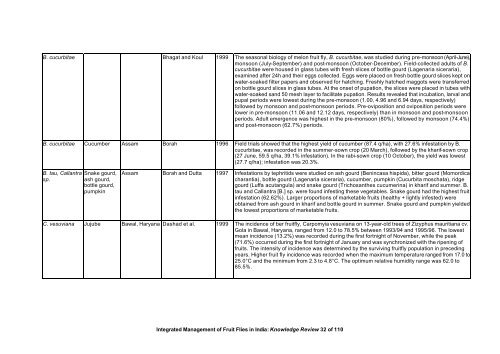“Key Informant Survey” of Production, Value, Losses and ... - DfID
“Key Informant Survey” of Production, Value, Losses and ... - DfID
“Key Informant Survey” of Production, Value, Losses and ... - DfID
You also want an ePaper? Increase the reach of your titles
YUMPU automatically turns print PDFs into web optimized ePapers that Google loves.
B. cucurbitae Bhagat <strong>and</strong> Koul 1999 The seasonal biology <strong>of</strong> melon fruit fly, B. cucurbitae, was studied during pre-monsoon (April-June),<br />
monsoon (July-September) <strong>and</strong> post-monsoon (October-December). Field-collected adults <strong>of</strong> B.<br />
cucurbitae were housed in glass tubes with fresh slices <strong>of</strong> bottle gourd (Lagenaria siceraria),<br />
examined after 24h <strong>and</strong> their eggs collected. Eggs were placed on fresh bottle gourd slices kept on<br />
water-soaked filter papers <strong>and</strong> observed for hatching. Freshly hatched maggots were transferred<br />
on bottle gourd slices in glass tubes. At the onset <strong>of</strong> pupation, the slices were placed in tubes with<br />
water-soaked s<strong>and</strong> 50 mesh layer to facilitate pupation. Results revealed that incubation, larval <strong>and</strong><br />
pupal periods were lowest during the pre-monsoon (1.00, 4.96 <strong>and</strong> 6.94 days, respectively)<br />
followed by monsoon <strong>and</strong> post-monsoon periods. Pre-oviposition <strong>and</strong> oviposition periods were<br />
lower in pre-monsoon (11.06 <strong>and</strong> 12.12 days, respectively) than in monsoon <strong>and</strong> post-monsoon<br />
periods. Adult emergence was highest in the pre-monsoon (80%), followed by monsoon (74.4%)<br />
<strong>and</strong> post-monsoon (62.7%) periods.<br />
B. cucurbitae Cucumber Assam Borah 1996 Field trials showed that the highest yield <strong>of</strong> cucumber (87.4 q/ha), with 27.6% infestation by B.<br />
cucurbitae, was recorded in the summer-sown crop (20 March), followed by the kharif-sown crop<br />
(27 June, 59.5 q/ha, 39.1% infestation). In the rabi-sown crop (10 October), the yield was lowest<br />
(27.7 q/ha); infestation was 20.3%.<br />
B. tau, Callantra<br />
sp.<br />
Snake gourd,<br />
ash gourd,<br />
bottle gourd,<br />
pumpkin<br />
Assam Borah <strong>and</strong> Dutta 1997 Infestations by tephritids were studied on ash gourd (Benincasa hispida), bitter gourd (Momordica<br />
charantia), bottle gourd (Lagenaria siceraria), cucumber, pumpkin (Cucurbita moschata), ridge<br />
gourd (Luffa acutangula) <strong>and</strong> snake gourd (Trichosanthes cucumerina) in kharif <strong>and</strong> summer. B.<br />
tau <strong>and</strong> Callantra [B.] sp. were found infesting these vegetables. Snake gourd had the highest fruit<br />
infestation (62.62%). Larger proportions <strong>of</strong> marketable fruits (healthy + lightly infested) were<br />
obtained from ash gourd in kharif <strong>and</strong> bottle gourd in summer. Snake gourd <strong>and</strong> pumpkin yielded<br />
the lowest proportions <strong>of</strong> marketable fruits.<br />
C. vesuviana Jujube Bawal, Haryana Dashad et al. 1999 The incidence <strong>of</strong> ber fruitfly, Carpomyia vesuviana on 13-year-old trees <strong>of</strong> Zizyphus mauritiana cv.<br />
Gola in Bawal, Haryana, ranged from 12.0 to 78.5% between 1993/94 <strong>and</strong> 1995/96. The lowest<br />
mean incidence (13.2%) was recorded during the first fortnight <strong>of</strong> November, while the peak<br />
(71.6%) occurred during the first fortnight <strong>of</strong> January <strong>and</strong> was synchronized with the ripening <strong>of</strong><br />
fruits. The intensity <strong>of</strong> incidence was determined by the surviving fruitfly population in preceding<br />
years. Higher fruit fly incidence was recorded when the maximum temperature ranged from 17.0 to<br />
25.0°C <strong>and</strong> the minimum from 2.3 to 4.8°C. The optimum relative humidity range was 62.0 to<br />
85.5%.<br />
Integrated Management <strong>of</strong> Fruit Flies in India: Knowledge Review 32 <strong>of</strong> 110

















